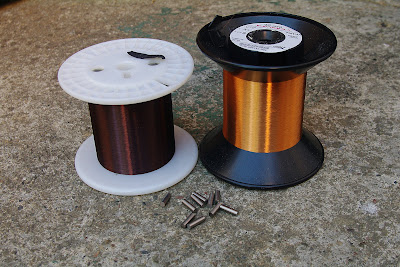The type and quality of wire and magnets used in constructing pickups has everything to do with the tone, so I use only the best, hand picked wire and magnets. I tested all of these different components myself and consulted the pros at Mojotone and SF Guitarworks to find the tonal properties of each. I offer pickups that are fully customizable to our customers. Here is a brief description of different types of components to help you choose what is best for your guitar.
pickups are essentially magnetic polepieces wrapped in thousands of
winds of copper wire. Like reverse electro-magnets!
winds of copper wire. Like reverse electro-magnets!
Magnets
Alnico is an acronym referring to the magnet's composition, aluminium (Al), nickel (Ni) and cobalt (Co)
Alnico V- cutting attack. by far the most popular magnet for vintage-style pickups. Drives your amp harder to break up sooner, lowers headroom. Tight punchy lows, low to moderate mids, singing highs.
Alnico III- the brightest of the alnico magnets. Lower output than Alnico V. Used in very early Teles and Strats from the 50's. Nice round highs and a strong midrange with good bite.
Alnico II- spongy attack. Smooth highs and strong mids. Lower output than Alnico V. Used in Gibson PAF humbuckers and some P-90's.
Wire
Formvar- (shown above on the spool on the right) common in vintage Fender and Gibson pickups. Pretty looking and sounding. Warm and smooth.
Single Build Plain Enamel- (shown above on the spool on the left) also used in many vintage Fender and Gibson pickups, useful when squeezing a maximum number of winds on the coil. Aggressive and sharper on the bass and treble response.
Poly- darker sounding overall. Very even tone. Great when used in high output pickups for smoothing out harshness. Used in some 60's and 70's CBS Fenders.
Construction Techniques
Scatterwinding- All of our single coil pickups are scatterwound, it is widely known in the pickup building world that scatterwinding is the best technique for building pickups because of the increased clarity and response to subtle details. It really opens up the sound. For more information see my blog entry on Scatterwinding.
Overwinding by 5%- some blues and rock players prefer pickups that drive their amp harder for more breakup through the amp. Overwound pickups also produce 5% more bass and 5% less treble. The high strings will sound fuller and sweeter but the wound strings will sound darker.
Underwinding by 5%- If clarity is your goal then underwinding is ideal. It produces 5% less bass and 5% more treble and makes your wound strings sound clearer.
Wax Potting- If you are using gain or excessive volume in your rig it is highly recommended that you order your pickups with wax potting. The hardened wax holds the windings together to keep them from vibrating against each other and causing feedback and microphonics. On the contrary, early Fender pickups were not wax potted and some are regarded as being some of the best sounding in the world, pickups without wax are generally more open sounding. For more information please see my blog entry on wax potting. All of our pickups are wax potted unless otherwise stated.
Staggered/Flat polepieces- Most modern pickups are staggered to compensate for fretboard radius and varying string-to-string balance in volume. You might notice that modern Strat pickups have quite a variety of polepiece heights, whereas Tele bridge pickups are mostly flat.
Beveled Polepieces- beveling the edge of the polepiece makes them look a little nicer. Some say that it smooths out the tone of the pickup as well. All of our Stratocaster, Jazzmaster, Jaguar, P-Bass, and Jazz Bass pickups have beveled polepieces unless otherwise stated.
Tele metal baseplate- Original telecasters came with a copper-plated steel baseplate under the bridge pickup. To most people the reason for this baseplate is a mystery, but the truth is that it serves four functions: 1. To increase the magnetic force and thus increase the inductance of the pickup resulting in more lows. 2. The baseplate is connected to the metal bridge with three metal screws that transfer some vibrations from the body to the pickup, resulting in that trademark "Tele twang". 3. The baseplate produces eddy currents that shift the resonance of the pickup towards the lows, resulting in a fatter, sweeter tone. 4. All grounded metalwork on pickups provide extra shielding.


